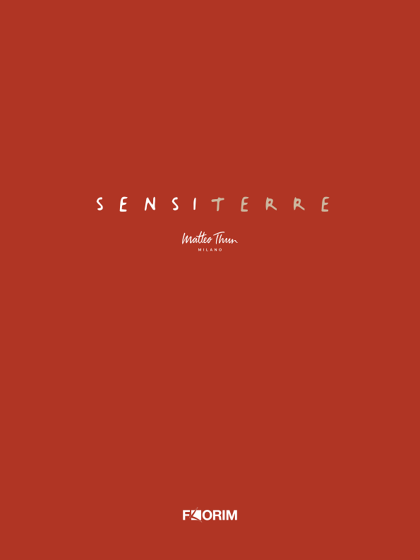Euridice Obliquo
Ceramic tiles from FLORIM, Designed by Giorgio Griffa
- Family gallery
- Family gallery
- Family gallery
- Family gallery
- Family gallery
- Family gallery
- Family gallery
- Family gallery
- Family gallery
- Family gallery
- Family gallery
- Family gallery
- Family gallery
- Family gallery
- Family gallery
Product description
Thickness 6mm - Size 120x240 cm
Concept
In the Euridice project, Giorgio Griffa continues his journey into the territories of the meaningful use of signs, an intimate, unique experiment in which he interacts with the intelligence of matter and explores its innermost structures.
The series created for CEDIT is strictly linked to the pictorial style and distinctive "graphic language" the artist has developed over his long career, also featuring his extremely subtle use of colour, the result of a relationship with the chromatic universe which, in Griffa's case, plays a major role in specifically identifying his works; the painted surfaces are geometrical reflections, linked by a relationship of mutual reliance and reciprocal interplay and attempting, not only with grace but also with lucid, intelligent obstinacy, to establish a balance between primary forms and space, managing to express, in the synthesis of this concise painterly language, the meaning of the work of art and of thought which transcends its time because it silently establishes itself within the web of history.
These are the concepts underlying Euridice, a dreamlike sequence, a blend of past and future, ancient and contemporary, which digs into the past, starting from the Orpheus myth, to emphasise the present's urgent need to find a sense of necessary depth, not just a "sudden flash of enlightenment" but an understanding achieved through passion and dedication.
As Griffa interprets it, Orpheus's journey into the underworld is a desperate attempt to explore the most mysterious part of the self, which cannot be grasped by rationality and disappears as soon as it is seen; Orpheus crosses the threshold of Hades in search of his female, creative side, which is pure mystery and therefore cannot emerge above the Earth and is trapped and sedimented in its womb.
The artist's distinctive graphic signs appear on the ceramic slabs in the collection as the expressions of concentration and a desire for knowledge; since they represent only themselves, they encourage the viewer to accept the truth of which they are the bearers. Apparently simple, these signs are steeped in references of an extraordinary complexity, derived from the history of painting, including the memory of Stone Age paintings themselves: if "the past is not a father to be killed but a mother who gives nourishment", the poetics of this series of ceramic slabs aim not to reveal an absolute truth but to offer the subtlest of suggestions, almost a fragrance, in a work which is both partial and infinite.
The series created for CEDIT is strictly linked to the pictorial style and distinctive "graphic language" the artist has developed over his long career, also featuring his extremely subtle use of colour, the result of a relationship with the chromatic universe which, in Griffa's case, plays a major role in specifically identifying his works; the painted surfaces are geometrical reflections, linked by a relationship of mutual reliance and reciprocal interplay and attempting, not only with grace but also with lucid, intelligent obstinacy, to establish a balance between primary forms and space, managing to express, in the synthesis of this concise painterly language, the meaning of the work of art and of thought which transcends its time because it silently establishes itself within the web of history.
These are the concepts underlying Euridice, a dreamlike sequence, a blend of past and future, ancient and contemporary, which digs into the past, starting from the Orpheus myth, to emphasise the present's urgent need to find a sense of necessary depth, not just a "sudden flash of enlightenment" but an understanding achieved through passion and dedication.
As Griffa interprets it, Orpheus's journey into the underworld is a desperate attempt to explore the most mysterious part of the self, which cannot be grasped by rationality and disappears as soon as it is seen; Orpheus crosses the threshold of Hades in search of his female, creative side, which is pure mystery and therefore cannot emerge above the Earth and is trapped and sedimented in its womb.
The artist's distinctive graphic signs appear on the ceramic slabs in the collection as the expressions of concentration and a desire for knowledge; since they represent only themselves, they encourage the viewer to accept the truth of which they are the bearers. Apparently simple, these signs are steeped in references of an extraordinary complexity, derived from the history of painting, including the memory of Stone Age paintings themselves: if "the past is not a father to be killed but a mother who gives nourishment", the poetics of this series of ceramic slabs aim not to reveal an absolute truth but to offer the subtlest of suggestions, almost a fragrance, in a work which is both partial and infinite.
More about this product
Categorised in Ceramic - Flooring - Wall coverings - Ceramic panels - Ceramic tiles - Ceramic flooring - Wall tiles - Colour beige - Colour multicoloured - Effect fabric - Porcelain stoneware - Outdoor / Garden.
Part of the collection
CEDIT.
Manufacturer
FLORIM
Family
Euridice
Architonic ID
1486740
Year of Launch
2016
More products from Euridice family
Downloads
Manufacturer’s Catalogues
Related Projects
Contact information
Address
Via Canaletto, 24 41042, 41042 Fiorano Modenese Italy
Get more information
Sign in to your Architonic account to have your contact details filled out automatically for each request.
Where to buy this product

More from
FLORIMContact information
Address
Via Canaletto, 24 41042, 41042 Fiorano Modenese Italy
Where to buy this product


